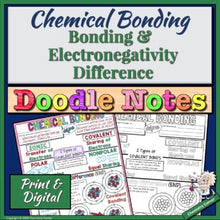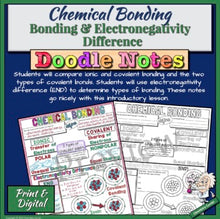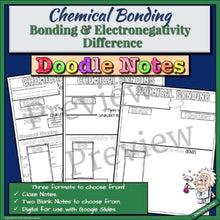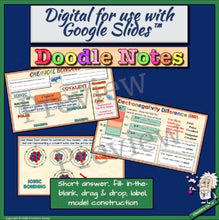With these notes, students will compare ionic and covalent bonding, and the two types of covalent bonds. They will use the electronegativity difference to determine type of bond. This is a great general introduction to chemical bonding that will hopefully bring back prior learning.
Students will gain so much value from these doodle notes that they will be proud of and use! Included with the resource is an example suggested KEY for completing the doodle notes. For interactive notebooks—just print at 90%, and it will fit beautifully!
Print & Digital Versions Included!
These notes go nicely with the Introduction to Chemical Bonding Lesson
Three versions for the notes included along with a suggested key.
Version 1: Cloze Notes – fill in the blank
Version 2: Blank notes with headings – you can add your own notes
Version 3: Blank Notes with minimal headings
Version 4: Digital for use with Google Slides™
Lesson Objectives:
* Define chemical bond
* Explain why most atoms form chemical bonds
* Describe ionic and covalent bonds and their formation
* Describe two types of covalent bonds – polar and nonpolar
* Classify bonding type according to electronegativity difference
Prior Knowledge:
Familiar with atomic structure
Lesson Duration: One class period
Included in This Resource:
* Doodle Notes- three versions – see above
* Suggested KEY
* Digital Version for use with Google Apps™
* Digital Version KEY
Teacher Prep Time: Just print and go
These doodle notes are appropriate for grades 9-12 chemistry, or physical science.
You will want to use these Doodle Notes year after year!
Chemistry Corner
*************************************************************************************Check out these other products that you may be interested in:
Chemical Bonding: An Introductory Lesson on Types of Chemical Bonds
Chemical Bonding: Ionic Bonds & Ionic Compounds
Chemical Bonding: Covalent Bonds & Lewis Structures
Chemical Bonding: Metallic Bonds
Chemical Bonding: The VSEPR Theory and Molecular Geometry
Intermolecular Forces & Molecular Polarity
Chemistry Doodle Notes for the Year – A Growing Bundle
High School Chemistry Year Curriculum: A Growing Bundle
*************************************************************************************
LICENSING TERMS: By downloading this product, you own a license for one teacher only for personal use in your classroom. Licenses are non-transferable, meaning they cannot be passed from one teacher to another. No part of this resource is to be shared with colleagues or used by an entire grade level, school, or district without purchasing the proper number of licenses. I you are a coach, principal or district interested in transferable licenses to accommodate yearly staff changes, please contact Chemistry Corner.
COPYRIGHT TERMS: ©Chemistry Corner. Please note – all material included in this resource belongs to Chemistry Corner. By downloading, you have a license to use the material, but you do not own the material. This resource, or any portion of this resource, may not be uploaded to the internet in any form, including classroom/personal websites or network drives, unless the site is password protected and can only be accessed by students—no other teachers or anyone else on the internet.








